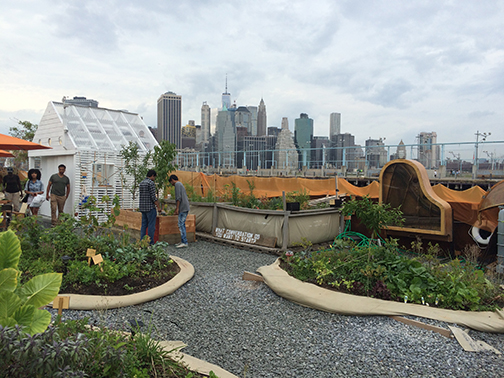
Swale is a provocative public artwork and a floating edible landscape on a reclaimed barge that launched in 2016. Growing or picking food on New York’s public land has been illegal for almost a century for fear that a glut of foragers could destroy an ecosystem. Swale utilizes marine common law in order to be public yet circumvent local public land laws. Swale is a folly, a floating edible landform that provides free food for harvest at the intersection of public art and service. With Swale, we want to reinforce water as a commons, and work towards fresh food as a commons too.
Swale came out of learning that in addition to over 100 acres of community garden space in NYC, the city cares for 30,000 acres of public parkland, while access to fresh food is limited. People visit Swale to pick edible and medicinal perennial plants for free.
In 2017, due to a confluence of Swale, a NYC Parks commissioner supportive of edible landscapes, and the strength and support of many community groups and stewards, NYC has opened its first “foodway” in Concrete Plant Park in the Bronx. If there continues to be stewardship interest, they could build more.
I grew up in an agricultural town outside of NYC where the drinking water was polluted. That framed my understanding of clean water as an increasingly rare resource that needed to be protected. So Swale came out of a need to connect with and rely upon New York’s waterways and public land in order to better care for it, and by proximity each other. Swale has been a tool to advocate for policy change. Since marine common law is different from New York City’s public land laws, Swale can pave a pathway to create public food in public space.
Artist: Mary Mattingly
Source: https://marymattingly.com/html/MATTINGLYSwale.html
Analysis:
This project begins to push the boundaries of what food access can look like. Specifically, through questioning how and when food can be grown, Swale opens a plethora of opportunities for innovation. This project illuminates the problems with food access while proposing a unique solution at the same time. The takeaway from this article that will assist the development of my thesis project include serving as a point of reference and divergence for what an “urban garden” can mean. Moving forward into my project I hope to utilize the ingenuity present within this project to create a product that seamlessly fits into existing notions of our food system while disrupting them at the same time. In other words, this project serves as a great example of feasibility vs. innovation.




